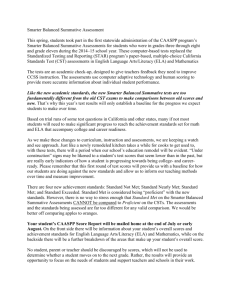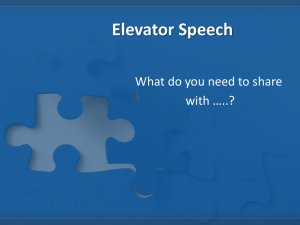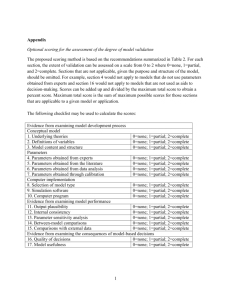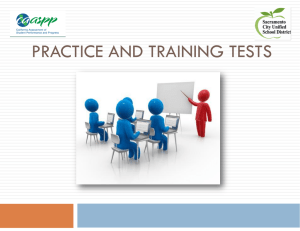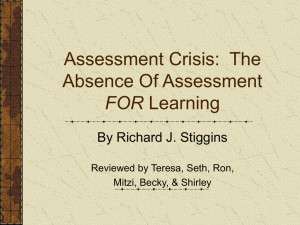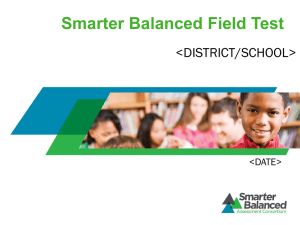Talking Points to Parents, Staff, Students, Community
advertisement
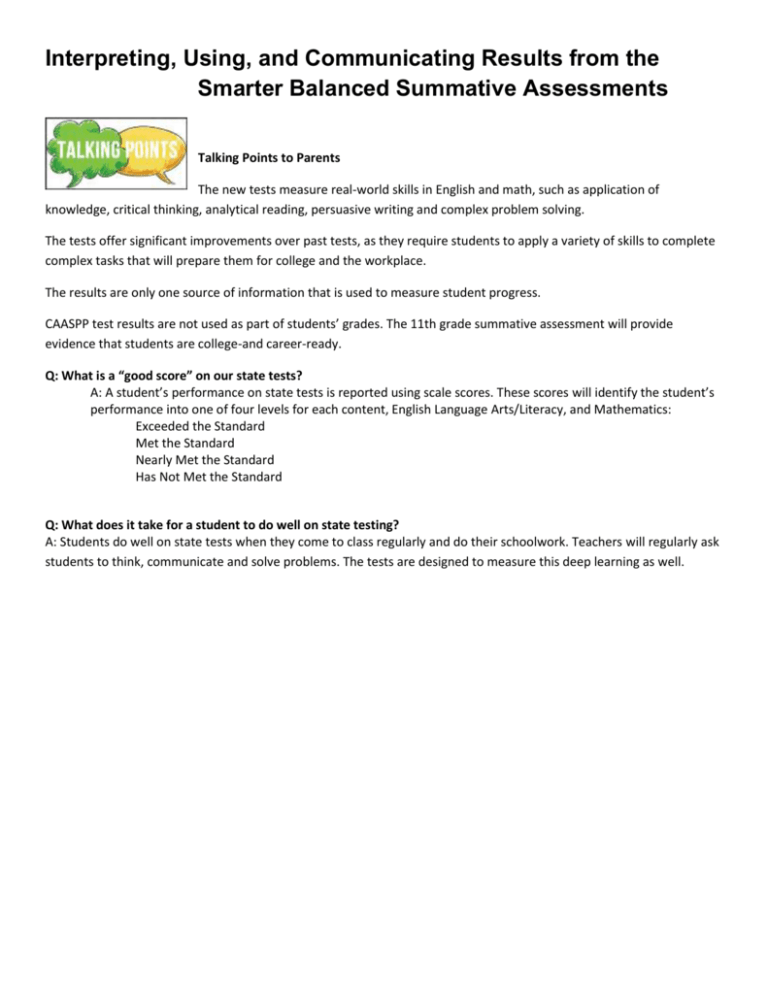
Interpreting, Using, and Communicating Results from the Smarter Balanced Summative Assessments Talking Points to Parents The new tests measure real-world skills in English and math, such as application of knowledge, critical thinking, analytical reading, persuasive writing and complex problem solving. The tests offer significant improvements over past tests, as they require students to apply a variety of skills to complete complex tasks that will prepare them for college and the workplace. The results are only one source of information that is used to measure student progress. CAASPP test results are not used as part of students’ grades. The 11th grade summative assessment will provide evidence that students are college-and career-ready. Q: What is a “good score” on our state tests? A: A student’s performance on state tests is reported using scale scores. These scores will identify the student’s performance into one of four levels for each content, English Language Arts/Literacy, and Mathematics: Exceeded the Standard Met the Standard Nearly Met the Standard Has Not Met the Standard Q: What does it take for a student to do well on state testing? A: Students do well on state tests when they come to class regularly and do their schoolwork. Teachers will regularly ask students to think, communicate and solve problems. The tests are designed to measure this deep learning as well. Interpreting, Using, and Communicating Results from the Smarter Balanced Summative Assessments Talking Points to Students The results are only one source of information that is used to measure progress. The standards for learning and the method for testing have changed. Tell students that adjusting to the new standards and this new way of learning may be difficult at first, but that all teachers and principals are working very hard to support them to learn in this new way. Reassure students that these tests are an important way to measure if their learning is on track. Remind them you will use other assessments as well. Tell students that they will have the opportunity to review their score results individually with you and discuss actions to improve learning and identify specific areas of content need. Lower test scores do not mean students didn’t learn enough or didn't work hard last year. Reassure students that a score that is lower from past years doesn’t mean they aren't learning or working hard enough. These are different tests that measure important knowledge and skills that weren’t part of past tests. Remind students that the tests are meant to help teachers support their learning. Reassure students that you believe in them and will support them in learning what they need to know in order to ensure college and career readiness and success. The test scores are not the full picture of who students are. Tell students that the tests are only one piece of what they know as a student and that the tests give teachers information about where support is needed. Explain that teachers also look at classwork, effort and other factors to get a full picture of who they are as a student. Tell students that when they face tests or schoolwork that seems really hard, it is important to keep trying and not give up. Reassure them it is okay to struggle and you believe they can meet the challenge. Remind them they should never be afraid to ask questions; they should ask their teachers and other adults questions regarding their schoolwork, the tests, and the new standards. Remind them that by continuing to work hard and persist through difficulties, they will be prepared to be successful in school and life. Talk about other ways in addition to determining students’ academic and learning needs through tests that teachers and the school are preparing them to be successful. Interpreting, Using, and Communicating Results from the Smarter Balanced Summative Assessments Talking Points to Staff The preliminary results are not appropriate for public release. Results may change as additional data are received and relevant appeals and rescores are processed. These changes may result in final scores being higher or lower than preliminary results. The California Department of Education (CDE) recommends that only be released publically following the state-level release of assessment scheduled for early September. Like apples and oranges, the new test results are too different to compare to the previous California Standards Test. This year’s scores establish a baseline for progress and continuous improvement in future years, and are a more accurate indicator for educators, students and parents as we work to meet the rigorous demands of college and career readiness Q: Who scores our state tests? A: Only professional scorers are hired to hand score written responses from our tests. A professional scorer has a four-year degree, most often in the content area they are scoring or a related content area. California contracts with Educational Testing Service to hire, train, and monitor the scoring of the tests. Scorers must continually and consistently meet criteria for accuracy and reliability. Q: How are student responses scored? A: Multiple choice and completion items are machine scored. Short answer and essay responses are scored by professionally trained scorers. Q: How are passing scores determined? A: Achievement-level setting, also known as standard setting, is the process for establishing one or more threshold scores on an assessment, making it possible to create categories of performance. Through a series of online and in-person activities, educators, parents, and community leaders help ensure the assessments are based on fair and rigorous expectations for students. Typically three threshold scores are set, establishing four levels of performance. Q: What steps are taken to make sure that the scoring of open-ended items is valid and reliable? A: Open-ended items are scored by professional scorers trained according to strict protocols. Scorers must then pass a qualifying test before being allowed to score an item or set of items. In addition to the training and qualifying processes, the validity and reliability of scoring are monitored throughout the time of scoring. Monitoring methods include doublescoring, read-behinds by scoring supervisors, and the insertion of pre-scored papers called validity papers used to monitor scorers. For more detailed information on item scoring. Interpreting, Using, and Communicating Results from the Smarter Balanced Summative Assessments Guiding Teacher Collaboration (Reflective) Questions to ask when examining results for students from the prior school year: How do results match areas where I provided instruction? Looking at students who met or exceeded standards, what factor(s) contributed to their success? Looking at students who were below standard, what instructional strategies or supplemental resources would I change? How could instructional time be adjusted to increase the number of students who are near standard or above standard? (Planning) Questions to ask when examining results for students who are new to you this year: What are the strengths and needs in my class(es) based on SBAC claims? How do these strengths and needs correspond with local assessments and reports? If there are patterns of need, what changes can I make to the year’s instructional plan to increase the number of students who are successful? How can I use formative assessment and SBAC Interim Assessments to gauge learning with students this year? What assistive technology can be employed to support student learning success? Interpreting, Using, and Communicating Results from the Smarter Balanced Summative Assessments Talking Points to Community (DAC, ELAC, SEPAC) CAASPP stands for the California Assessment of Student Performance and Progress and is aligned with California’s new rigorous state standards. This is an exciting and important transition that will benefit students, parents and the whole community as we prepare our students for college and career readiness. The Smarter Balanced test was administered to California public school students in grades 3-8 and grade 11 in English language arts and mathematics in spring 2015. The new standards and assessments are part of California’s new accountability system to help all students graduate high school prepared for success. The new tests measure real-world skills in English and math, such as application of knowledge, critical thinking, analytical reading, persuasive writing and complex problem solving. Administered online, the assessments adapt to each student’s ability by basing the difficulty of future questions on previous answers, providing a more accurate measure of student achievement. Designated supports, accessibility resources and accommodations are available for all students who need them allowing virtually all students to demonstrate what they know and can do. The CAASPP tests offer significant improvements over past tests, as they require students to apply a variety of skills to complete complex tasks that will prepare them for college and the workplace. Think of the assessments as an academic checkup for students. In addition, to the annual test, they provide realtime information during the year to give teachers and parents a better picture of where students are succeeding and where they need help. Additionally, our state universities recognize student scores on the grade 11 assessments as an indication that students are ready for introductory college coursework without the need for non-credit remedial courses. Q: Is a listing of school and/or district state testing scores available? A: Sometime in early September, the site, district, county, and statewide scores will be reported on CDE’s DataQuest http://dq.cde.ca.gov/dataquest/. Scores are not posted for individual student scores. Q: How are test results reported? A: Results are reported for individual students, schools, districts, and the state. Every family of a student who takes a state test receives a score report. Those will be mailed to homes and should be expected to be received by mid-September. Q: How are state test results used? A: State test results are used to make improvements in teaching and learning. Parents, students, and educators use the results to: Follow student progress. Identify strengths, weaknesses, and gaps in curriculum and instruction. Fine tune curriculum alignment with the statewide standards. Identify students who may need additional help. Test results will also be used for school and district accountability beginning with the 2016 testing.
